Robb Recommends: Giorgio Armani Made to Measure Is Quiet Luxury Cranked Up to 11

Welcome to Robb Recommends, a regular series in which our editors and contributors endorse something they’ve tried and loved—and think will change your life for the better. If you purchase a product or service through a link in this story, we may receive a small commission.
I have a friend who doesn’t get the whole stealth-wealth thing. Not the appeal, you understand, but the rebranding. The notion that it’s somehow new. “It’s beautiful clothes made beautifully, no?” she asks. She’s one of those effortless and annoyingly chic types who still likes a glass of wine with lunch and a cigarette with her wine, and who can communicate entire indented paragraphs using nothing but a semaphore of fluttered eyebrows. I suggest there’s more to it than that, that it’s about beautiful things, yes, but ones that don’t shout or make a fuss about their beauty or quality, or about costing more than a decent motorcycle. The brows twist into a barely inaudible scoff—“Oh, we’re pretending there’s a difference?”—then she shrugs and adds, out loud this time, “We used to just call it Armani.”
More from Robb Report
Justin Timberlake Wears an $80,000 Tiffany & Co. Link Necklace to the MTV Video Music Awards
Robb Recommends: Claus Porto's New Cologne Smells Like Sailing in the Summertime
Giorgio Armani didn’t invent the idea of tastefully muted basics at ear-popping prices, of course, but no one presaged the current moment in such uncanny detail. That the designer dressed Richard Gere for his breakout role in 1980’s American Gigolo is part of his lore, but watch it again. Gere alone in the film is shockingly modern, eerily of the moment down to the gold Cartier and single pleats, and it’s everything to do with his clothes: a soft, loose uniform of decadent pieces, often worn in monochrome, that move like he moves—with a voracious appetite for seduction. The politicians and cops slide off the screen in their worsteds and stiff polyester but Gere grabs the eye like he parachuted in from another movie entirely, strutting in Technicolor through a black-and-white world. It’s impossible to look around now and not see the soft, slouchy, Armani-shaped hole running through the credit reel of our current quiet luxury obsession.

So I trekked the fifteen blocks from Robb Report’s Manhattan offices to the Giorgio Armani flagship store on Fifth Avenue. Inside the towering glass cube a white Fuksas staircase unfurls 70 feet toward the ceiling like a giant, petrified billow of cigar smoke. At the top, around the corner from the restaurant, is Giorgio Armani Made to Measure, a semi-private lounge enclosed by racks of samples, not only the designer’s red-carpet-famous formalwear and tailoring but buttery soft moto jackets, denim, knits, even drawstring trousers.
Made-to-measure programs have boomed since the pandemic’s cozifying effect across fashion. More people want more input into the fit and finish of more of their everyday wear, and they’re willing to pay more for the privilege. But that’s actually a trickier proposition than it sounds. We can (and should) romanticize the exacting, myopic, chalk-fingered handiwork of custom tailoring, but when it comes to personalization, factory-led made-to-measure has the harder job by far. Manufacturing and alteration are natural enemies. The point of automation is to do the same thing again and again as quickly as possible; customization is doing a unique thing once. So while it’s nice that a handful of your favorite micro-brands are now offering MTM overshirts and bombers, whether they’re any good or not comes down to the factories that produce them. Which is just a long way of saying that the advantage of made-to-measure from a label that’s been operating at the highest level of Italian luxury going on 50 years should need no mention.
Thomas Recchia, head of personalization for Giorgio Armani, tall and dashingly Italian, orders me an espresso and strolls through the options, pulling samples off hangers and shelves, turning jackets inside out, describing the construction, noting which aspects of the designs are fungible and which fixed. Armani’s MTM program, too, is on the move, with a moody black-and-white ad campaign and a swanky Personalization Room in the new Beverly Hills boutique. The leather pieces all look soft enough to sleep in and I spend an unreasonably long time fingering the hem of a midnight blue peak-lapel tuxedo, but I stick to what drew me: basics. Because the appeal of Giorgio Armani has always been the idea that there’s actually no such thing as basic, provided what you make is shockingly luxurious and bombastically expensive enough, and the best way to test that thesis is with the simplest, most menial, least considered pieces possible. The attire of weekend grilling, or mini-golf: A navy polo and gray slacks.
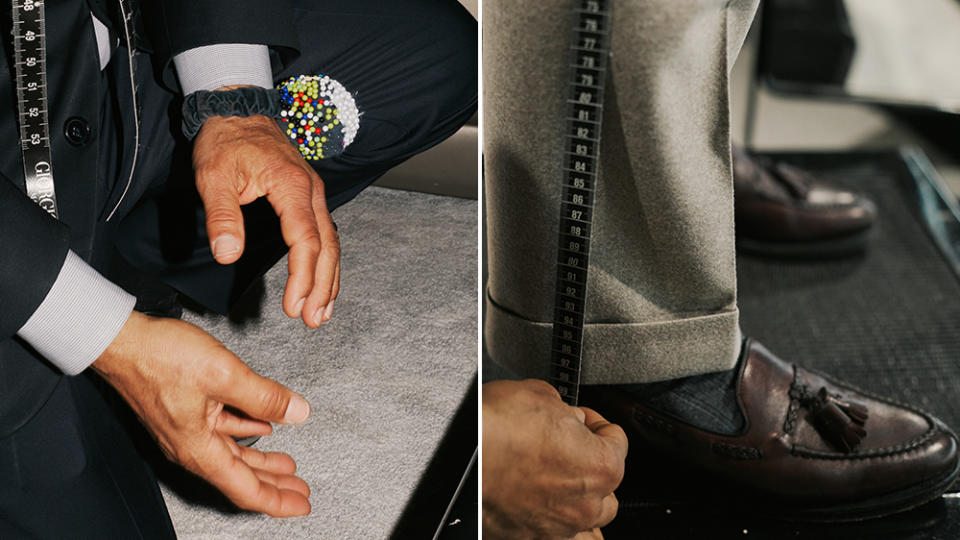
Halfway into one of the fabric books my fingers ferret out a snatch of cloth, downy as a baby’s blanket, and it triggers a soft purring noise that I hope I’m only making in my head. I had come looking for this moment. Armani may be best known for his radically relaxed approach to the suit but his reputation is equally staked on an innovative approach to textiles, honed in the ’70s under fellow Milanese master Nino Cerruti. The key to that famously exaggerated slouch of a silhouette was his pioneering use of lighter materials, like silk, long considered the purview of women’s clothes, and few of the labels we covet today from Umit Benan to Gabriela Hearst could exist without that resounding step.
Out of over 500 fabric choices just for the flat-front SoHo trousers I select one such material, a silk-linen blend in a dark, dusty slate gray. For the long-sleeve polo, a supremely fine-gauge navy merino that spreads across the table like spilled ink. In a private fitting room concealed behind a section of curved wall, director of central alterations Jose Nolasco measures with the speed and sweeping precision of an orchestra conductor, deftly squaring shoulders, raising arms, plucking and pinning and cocking his head. Recchia, Nolasco, and I have a detailed conversation about the various changes—broader shoulders, a higher rise, a left arm ever so slightly longer than the right—and then the design forms are given final notations, handshakes are exchanged, and I go home to start the long wait. The interminable, foot-tapping intermission known to anyone who spends too much on well-made clothes, which ultimately no amount of money, status, connections, or religion can hurry along.
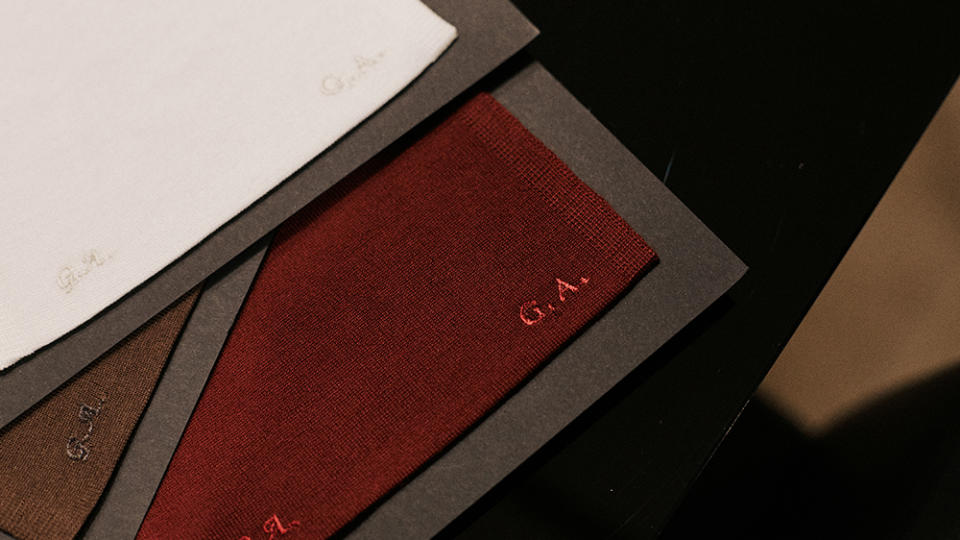
Nearly eight weeks to the day later the pieces arrive from Italy and I rejoin Jose for a second and final fitting. A week after that I receive a pair of large dark boxes with embroidered labels reading “Giorgio Armani for JC,” which match the smaller versions inside the clothes.
Sitting as it does on the road between ready to wear and fully bespoke, any made-to-measure program includes itchy little doubts about value for money, particularly for trousers that start at $1,000 and knitwear at $1,295. No matter how much the initial flurry of activity feels like bespoke, no matter how impressive the fabric library or involved the design discussions, all the pinning and measuring aside, at some point you bump into that invisible fence of small concessions, look back, and realize how close you still are to off-the-rack. At which point you wonder: How much better than superlative ready to wear can it actually be?
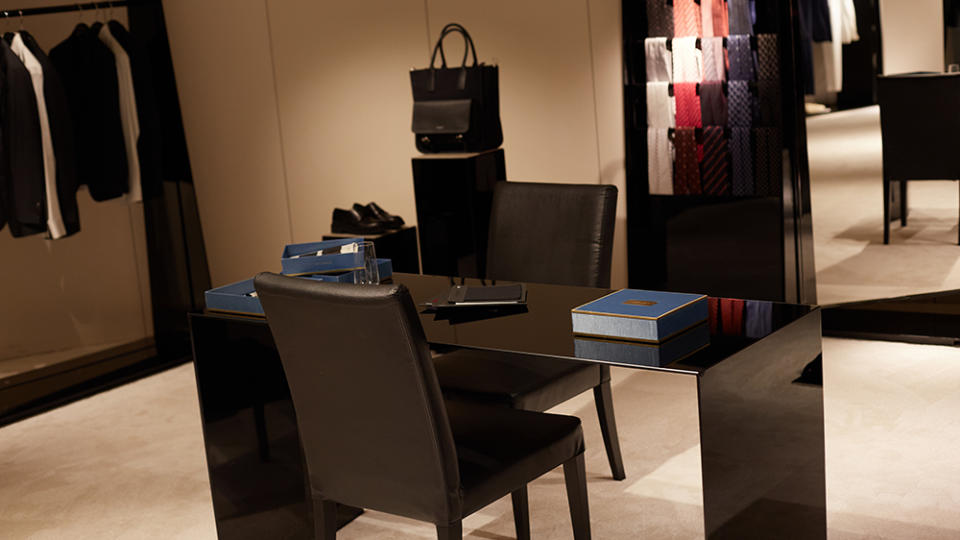
The answer is in the construction. This, too, the designer saw coming. The company’s inventive early business model married exacting, designer-led but factory-produced ready-to-wear with blinding high fashion prices. It was instantly, smashingly successful. One might even argue that Giorgio Armani S.p.A., founded in 1975, is the brand most responsible for today’s high-tech manufacturing wonderland of digitally patterned, air-woven, laser-cut—or, as you might think of it, Made in Italy—luxury goods.
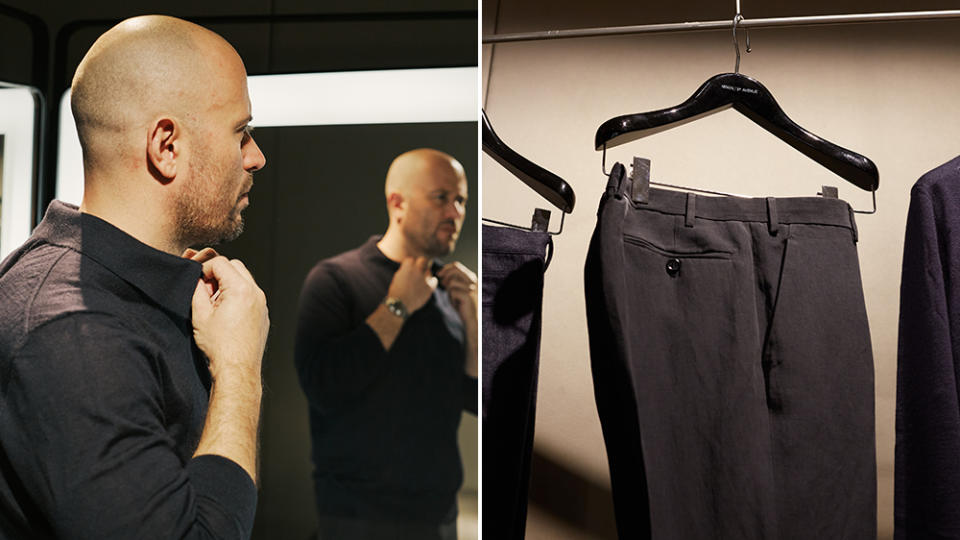
To this day, the brand’s precision construction remains remarkable. The dark, dusty trousers look like they’re hewn from Ligurian slate but wear as light as birdsong; the French seams on the polo are sewn so tightly as to be nearly invisible, and the fit and drape have the aestheticizing effect of an Austrian spa vacation. And like the best made-to-measure, both feel far closer to bespoke than off-the-rack: What you notice most is how little you notice. No bunching, no constricting tugs or too-long sleeves or a shirtwaist that jumps halfway up your back when you place a bag into the overhead.
There are minor imperfections (the topmost of the polo’s four buttonholes arrived unfinished and a touch ragged) and the shirt’s large, soft collar, the only option, gets helplessly flummoxed under even a light blazer. But don’t let that distract from the far more important point, which is how the clothes are meant to make you feel.
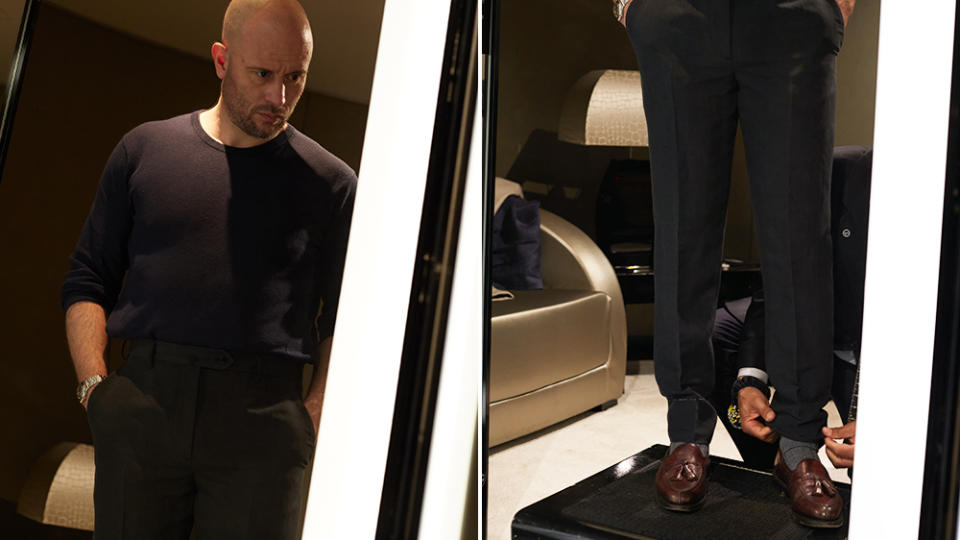
There have only been a few moments when I’ve tried something on and immediately understood the designer’s vision. Usually it’s subtle—a certain way of standing, or walking. An extra button done up, or undone. Channeling Giorgio Armani is more potent and altogether more complex. The feeling is militantly decadent and aggressively sensual, but the word that claws to the top of the pile is obsessive: a relentless, exacting pursuit of opulence. Taking off Armani is like getting out of a Rolls-Royce for the first time and suddenly wondering why the rest of the world was built so ugly, harsh, and loud, and it’s no wonder generations of the affluent have self-medicated with both. Admittedly, a lot of feelings from a pair of trousers and a polo, but credit where it’s due: They’re anything but basic. Which is to say if you’ve ever questioned what all the fuss was about, wondered whether the designer’s impact was actually that meteoric, raised an eye at the prices or scoffed at the legend of the departed connoisseur with “Wardrobe by Giorgio Armani” chiseled on his tombstone, well, you’ve never walked a mile in my pants.
The best part of both pieces is how relaxed and easy they are—no pointless flourishes, nothing to draw the eye. Except, of course, that everything draws the eye. That’s the simple but consuming seduction of beautiful clothes made beautifully: They don’t look like much until you really look at them, at which point you don’t want to look anywhere else. If you’re the type who’s never quite understood the appeal of quiet luxury, try starting there.
Giorgio Armani Made to Measure
Program categories include Evening, Formal Wear, Denim, Knitwear, Leather, and Upton (the brand’s deconstructed line)
Reviewed:
Starting price, trousers: $1,000
(As commissioned: $1,000)
Starting price, knitwear: $1,295
(As commissioned: $1,295)
Best of Robb Report
Sign up for Robb Report's Newsletter. For the latest news, follow us on Facebook, Twitter, and Instagram.


